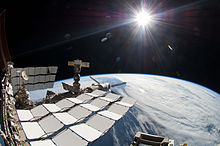
Back Sonlig Afrikaans أشعة الشمس Arabic شعا د شمش ARY ৰ'দ Assamese Слънчево излъчване Bulgarian घाम Bihari রোদ Bengali/Bangla Llum solar Catalan Sluneční světlo Czech Sollys Danish


Sunlight is a portion of the electromagnetic radiation given off by the Sun, in particular infrared, visible, and ultraviolet light. On Earth, sunlight is scattered and filtered through Earth's atmosphere as daylight when the Sun is above the horizon. When direct solar radiation is not blocked by clouds, it is experienced as sunshine, a combination of bright light and radiant heat (atmospheric). When blocked by clouds or reflected off other objects, sunlight is diffused. Sources estimate a global average of between 164 watts to 340 watts[1] per square meter over a 24-hour day;[2] this figure is estimated by NASA to be about a quarter of Earth's average total solar irradiance.
The ultraviolet radiation in sunlight has both positive and negative health effects, as it is both a requisite for vitamin D3 synthesis and a mutagen.
Sunlight takes about 8.3 minutes to reach Earth from the surface of the Sun.[3] A photon starting at the center of the Sun and changing direction every time it encounters a charged particle would take between 10,000 and 170,000 years to get to the surface.[4]
Sunlight is a key factor in photosynthesis, the process used by plants and other autotrophic organisms to convert light energy, normally from the Sun, into chemical energy that can be used to synthesize carbohydrates and fuel the organisms' activities.
Daylighting is the natural lighting of interior spaces by admitting sunlight. Solar irradiance is the solar energy available from sunlight.
- ^ "Climate and Earth's Energy Budget". earthobservatory.nasa.gov. 14 January 2009. Retrieved 2022-01-27.
- ^ "Basics of Solar Energy". Archived from the original on 2016-11-28. Retrieved 2016-12-06.
- ^ Bell Burnell, S. Jocelyn (2004). An Introduction to the Sun and Stars (illustrated ed.). Cambridge University Press. p. 56. ISBN 9780521546225. Extract of page 56
- ^ "The 8-minute travel time to Earth by sunlight hides a thousand-year journey that actually began in the core". SunEarthDay.NASA.gov. NASA. Archived from the original on 2012-01-22. Retrieved 2012-02-12.

